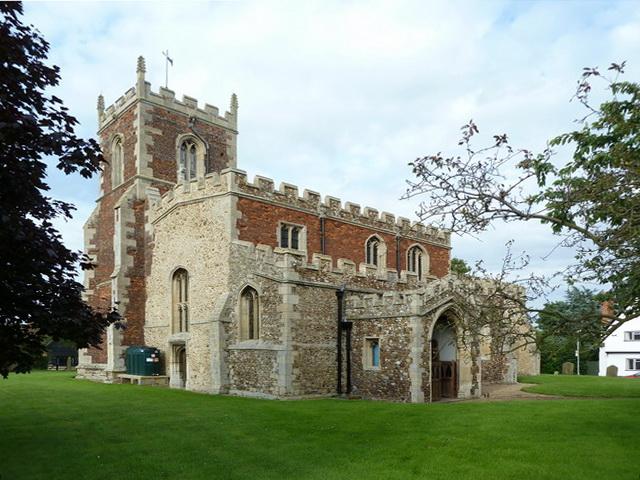St Mary
St Neots, Cambridgeshire
The 9th century monk after whom this town is named lived and died at St Neot in Cornwall, his relics were later brought here, so a second town is named for him.

A Grade I listed church in Cambridgeshire with splendid Norman carvings over south entrance and other ancient features.
Southoe, Cambridgeshire
The first stone church at Southoe was erected in about 1180, under the patronage of Nigel de Lovetot, lord of the manor. The church’s dedication was to St Leonard, but there was also at one time an image of St Nicholas within the church. Both saints are connected with captives or prisoners of war but since Nigel de Lovetot was 'a clerk in holy orders' it seems unlikely that he was ever held captive and he may have dedicated the church in memory of another family member. It is possible that there was, prior to the stone church, one built of timber.
There is no reference to such a church in Domesday Book of 1086 but 'Godric the priest' is listed as holding land in the parish and where there was a priest there was usually a church. The first stone church may have consisted of a simple two cell structure of nave and chancel but it was richly decorated. There are small carvings still in situ on each side of the chancel arch, and the south doorway is one of the most elaborately carved in the country. At each side the half columns are carved with diamond and ball patters, topped by foliage. Above this the tympanum over the door is deeply incised with a chequerboard design, and above that several mouldings bear a variety of designs. In 1333 the church was widened to the south to form an aisle which became the Lady Chapel. The magnificent doorway was moved to the aisle’s outer wall and at the same time, or a little later, a porch was added.
In about 1460 another aisle was constructed on the north side. This became a private chapel for the local manorial overlords, by that time the Rous family. A series of letters, some missing, round the external gable of the chapel; are in abbreviated Latin and indicate that this section was built by Thomas Rous in memory of his father. The north chapel almost certainly once extended further but a part of it was later sacrificed to make room for a brick built tower. The bricks for this were produced in the late 15th or early 16th century at a brick kiln which now lies under Grafham Water. The most interesting and revealing description of how Southoe church once looked when it was in its most colourful and resplendent state appears in a Visitation Report of 1613. The report contains illustrations of a number of heraldic shields including those relating to noble families such as the Clares, Staffords, Ferrers and Rouses. Several shields have signs denoting colours, which meant that they were either set into stained glass or were coloured carvings on tombs. There were a number of inscriptions on the church walls, including a list of lords of the manor between 1296 and 1453, beginning with 'Thomas Lovetofte'.
In the north chapel there is a large stone slab which once covered a tomb. It shows a carving of a priest lying with his head on a cushion and his body covered by a cloth or pall. This was the lid of the tomb of John of Clipstone, a former Rector of the church who died in 1334.
The present church has such an unusual square floor plan, and the western end is so roughly finished that it seems likely that at some time the structure was severely shortened, but there seems to be no record of this. The western doorway is late 16th century. It has a square headed moulding above, in the corners of spandrels of which are the initials I and B. This doorway was paid for by John Baldwin who was patron of the church in 1582. The present church and its village give little indication of the parish’s illustrious past. Following the Norman Conquest the manor was acquired by Eustace, Sheriff of Huntingdon. By the end of the 12th century Southoe was the seal of a Barony with associated land holdings in several other Huntingdonshire parishes. Tenants of the various properties attended meetings of the Baronial Court to pay their dues and to pay homage to their overlord. On March 5th 1207, the court was graced with a visit from King John. Since the only other places visited by the king during this 'progress' were Kimbolton, Cambridge and Huntingdon, all of which had castles, it indicates that Southoe had a similarly prestigious reputation at the time.
The present residents of the village were probably unaware of the illustrious past of this modes and unassuming parish.
St Neots, Cambridgeshire
The 9th century monk after whom this town is named lived and died at St Neot in Cornwall, his relics were later brought here, so a second town is named for him.
Little Paxton, Cambridgeshire
A 900 year old Grade II* building with great architecture and modern facilities which is open every day for community events.
Great Paxton, Cambridgeshire
Stunning Anglo-Saxon church in Cambridgeshire which Pevsner describes as 'the interior is not only a surprise, it is also an architectural shock of a high order'.